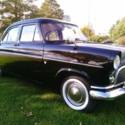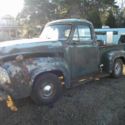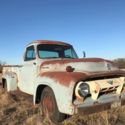1954 Ford Consul Zephyr Six All Original!!!
- Price:
- Location: Salem, Massachusetts, United States
- Condition: Used
- Make: Ford
- Model: Other
- Type: Sedan
- Trim: Zephyr
- Year: 1954
- Mileage: 40,529
- VIN: 675c27700
- Color: White
- Engine size: Inline six
- Number of cylinders: 6
- Fuel: Gasoline
- Transmission: Manual
- Drive type: RWD
- Interior color: Red
- Options: Leather Seats
- Vehicle Title: Clear
1954 Ford Other Description
Chassis number: EOTTA147596The first of the Zephyr range was a lengthened version of the four-cylinder 1,508cc (92cuin) Consul, with a 2,262cc (138cuin) six-cylinder engine producing 68bhp (51kW). Like the Consul, the Zephyr came with a three-speed gear box, controlled by a column-mounted lever.[3] The front suspension design, based on that first seen in the Ford Vedette, employed what would later come to be known as MacPherson struts[4] while a more conventional configuration for the rear suspension used a live axle with half-elliptic springs. The car could reach just over 80mph (130km/h) and 23mpg.
The Ford Zephyr Six was available with 4-door saloon, estate and two-door convertible bodies. The convertible version was made by Carbodies and had a power-operated hood; the estate car was by Abbotts of Farnham and was sold as the Farnham.
In addition to the main British Ford factory in Dagenham, the Consul and Zephyr were assembled at Ford New Zealand's Seaview factory in Lower Hutt from CKD kits. The large Fords competed with the also locally built Vauxhall Wyvern and Velox and, later the Australian Holden. When the newly crowned Queen Elizabeth II visited New Zealand as part of a Commonwealth tour in the early 1950s, she was pictured watching Zephyrs being built at the local Ford plant.
In 1953, a Ford Zephyr Six driven by Maurice Gatsonides won the Monte Carlo rally, pushing a Jaguar Mark VII into second place in the process. Two years later a Ford Zephyr Six driven by Vic Preston (Snr) and D P Marwaha won the East African Safari Rally.[5]
A saloon tested by The Motor magazine in 1951 had a top speed of 79.8mph (128.4km/h) and could accelerate from 0–60mph (97km/h) in 20.2 seconds. A fuel consumption of 23.7 miles per imperial gallon (11.9L/100km; 19.7mpg-US) was recorded. The test car cost £842 including taxes but was fitted with optional leather trim, heater and radio.[2]
This Ford is all original and in good running condition, although a complete running example, she would benefit from an enthusiastic owner for her to get back to her former glory days.
With 40529 original miles she Starts and runs smoothly. Recently rebuilt the brakes and cleaned carbs. No electrical issues. No missing trim pieces, no missing mouldings, undercarriage is in great condition with no rust. The car does not need any floorpan work.The interior, like the body is all original, the leather seats could do with some repairs. It currently needs a brake switch, so the brakes could be bled.
This car has been kept in the garage for some time and it is now time for her to find a new home.
This is a rare car that has a great history in the automotive world. The first car to come equipped with MacPherson struts. Won the Monte Carlo Rally, it competed and beat the following:
Jaguar MK& 3.4
Citroen 15-6
Panhard Dyna x86
Jaguar MK5 and mk7 3.4
Sunbeam Talbot 90
Lancia Aurelia B21
Allard K2 Sport
Lancia Aurelia B 20 GT
Peugeot 203
Renault 4 CV
Alfa Romeo 1900
DKW F 91
Citroën 15 - 6
I currently still have the owners manual, repair manual, original posters and marketing ads from when the car was new.
Please feel free to contact me with any questions. Bid with confidence!!! NO RESERVE
Ps: A 500.00 deposit is required within 48 hours after the auction, remaining payment is due at vehicle pick up.
Buyer IS responsible for pick up and delivery.
 Ford Zephyr Zodiac mk 1 LHD 1954
Ford Zephyr Zodiac mk 1 LHD 1954
 Ford Consul Capri
Ford Consul Capri
Mileage: 123,456
 1964 Ford Consul Corsair GT
1964 Ford Consul Corsair GT
Mileage: 88,000
 1956 Ford Consul MK II Sedan 4-Door 1.7L
1956 Ford Consul MK II Sedan 4-Door 1.7L
Mileage: 65,000
 1960 Ford Consul MK2 Convertible (English Ford)
1960 Ford Consul MK2 Convertible (English Ford)
Mileage: 100,000
 1932 Ford Roadster Lincoln Zephyr V12 Engine-Quick Change Rearend
1932 Ford Roadster Lincoln Zephyr V12 Engine-Quick Change Rearend
Mileage: 1,100
 Ford F-100 1954 ORIGINAL RESTORATION
Ford F-100 1954 ORIGINAL RESTORATION
Mileage: 3,000
 1954 Ford F250, 6 cyl, Original
1954 Ford F250, 6 cyl, Original
 1954 Ford F-100 Custom, Original, No Reserve
1954 Ford F-100 Custom, Original, No Reserve
Mileage: 99,999
 1954 Ford F-250 All Original Texas Survivor
1954 Ford F-250 All Original Texas Survivor
Mileage: 54,600












